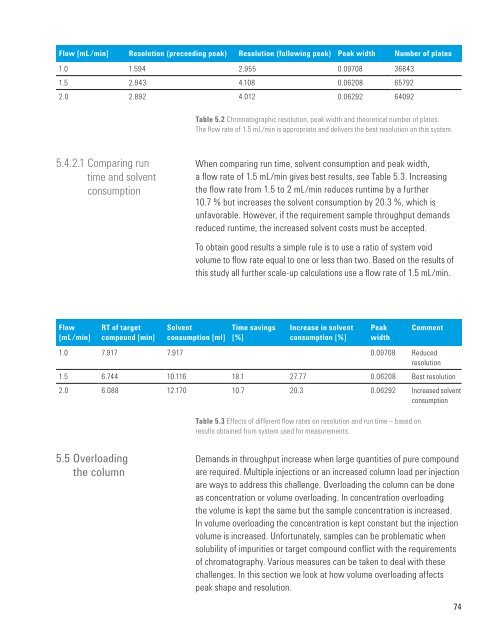Principles and Practical Aspects of Preparative Liquid Chromatography
Create successful ePaper yourself
Turn your PDF publications into a flip-book with our unique Google optimized e-Paper software.
Flow [mL/min] Resolution (preceeding peak) Resolution (following peak) Peak width Number <strong>of</strong> plates<br />
1.0 1.594 2.955 0.09708 36843<br />
1.5 2.943 4.108 0.06208 65792<br />
2.0 2.892 4.012 0.06292 64092<br />
Table 5.2 Chromatographic resolution, peak width <strong>and</strong> theoretical number <strong>of</strong> plates.<br />
The flow rate <strong>of</strong> 1.5 mL/min is appropriate <strong>and</strong> delivers the best resolution on this system.<br />
5.4.2.1 Comparing run<br />
time <strong>and</strong> solvent<br />
consumption<br />
When comparing run time, solvent consumption <strong>and</strong> peak width,<br />
a flow rate <strong>of</strong> 1.5 mL/min gives best results, see Table 5.3. Increasing<br />
the flow rate from 1.5 to 2 mL/min reduces runtime by a further<br />
10.7 % but increases the solvent consumption by 20.3 %, which is<br />
unfavorable. However, if the requirement sample throughput dem<strong>and</strong>s<br />
reduced runtime, the increased solvent costs must be accepted.<br />
To obtain good results a simple rule is to use a ratio <strong>of</strong> system void<br />
volume to flow rate equal to one or less than two. Based on the results <strong>of</strong><br />
this study all further scale-up calculations use a flow rate <strong>of</strong> 1.5 mL/min.<br />
Flow<br />
[mL/min]<br />
RT <strong>of</strong> target<br />
compound [min]<br />
Solvent<br />
consumption [ml]<br />
Time savings<br />
[%]<br />
Increase in solvent<br />
consumption [%]<br />
Peak<br />
width<br />
Table 5.3 Effects <strong>of</strong> different flow rates on resolution <strong>and</strong> run time – based on<br />
results obtained from system used for measurements.<br />
Comment<br />
1.0 7.917 7.917 0.09708 Reduced<br />
resolution<br />
1.5 6.744 10.116 18.1 27.77 0.06208 Best resolution<br />
2.0 6.088 12.170 10.7 20.3 0.06292 Increased solvent<br />
consumption<br />
5.5 Overloading<br />
the column<br />
Dem<strong>and</strong>s in throughput increase when large quantities <strong>of</strong> pure compound<br />
are required. Multiple injections or an increased column load per injection<br />
are ways to address this challenge. Overloading the column can be done<br />
as concentration or volume overloading. In concentration overloading<br />
the volume is kept the same but the sample concentration is increased.<br />
In volume overloading the concentration is kept constant but the injection<br />
volume is increased. Unfortunately, samples can be problematic when<br />
solubility <strong>of</strong> impurities or target compound conflict with the requirements<br />
<strong>of</strong> chromatography. Various measures can be taken to deal with these<br />
challenges. In this section we look at how volume overloading affects<br />
peak shape <strong>and</strong> resolution.<br />
74



